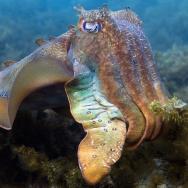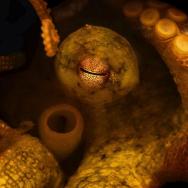Octopuses are the undisputed darlings of the science internet world, and for good reason. They’re incredibly intelligent problem-solvers and devious escape artists with large, complex nervous systems. They have near-magical abilities to change colors, skin textures and shapes instantaneously, and they can regenerate missing arms at will.
But the final days of a female octopus after it reproduces are quite grim, at least to human eyes. Octopuses are semelparous animals, which means they reproduce once and then they die. After a female octopus lays a clutch of eggs, she quits eating and wastes away; by the time the eggs hatch, she dies. In the later stages, some females in captivity even seem to intentionally speed along the death spiral, banging into the sides of the tank, tearing off pieces of skin or eating the tips of their own tentacles. (If you’re wondering, the males don’t get off any easier. Females often kill and eat their mates; if not, they die a few months later, too).
In 1977, Brandeis University psychologist Jerome Wodinsky showed that if he removed the optic gland from female Caribbean two-spot octopuses (Octopus hummelincki), something interesting happened. The optic gland is similar to the pituitary gland of most land animals, so-called because it sits between the eyes. Without them, the female octopuses abandoned their eggs, resumed feeding and some even mated again. At the time, Wodinsky and other cephalopod biologists concluded that the optic gland must secrete some kind of “self-destruct” hormone, but just what it was or how it worked was unclear.
A new study by neurobiologists at the University of Chicago uses modern genetic sequencing tools to describe several distinct molecular signals produced by the optic gland after a female octopus reproduces. The study, published in the Journal of Experimental Biology, also details four separate phases of maternal behavior and links them to these signals, suggesting how the optic gland controls a mother octopus’ demise.
“We're bringing cephalopod research into the 21st century, and what better way to do that than have this unveiling of an organ that has historically fascinated cephalopod biologists for a long, long time,” said Z. Yan Wang, a graduate student in neurobiology at UChicago who led the research study.
“These behaviors are so distinct and so stereotyped when you actually see them. It’s really exciting because it’s the first time we can pinpoint any molecular mechanism to such dramatic behaviors, which to me is the entire purpose of studying neuroscience,” she said.
Mapping the death spiral
In 2015, Clifton Ragsdale, professor of neurobiology at UChicago, and his team sequenced the genome of the California two-spot octopus (Octopus bimaculoides), the first cephalopod ever to be fully sequenced. Wang was a part of that research team and has continued building on that foundation for her PhD thesis.
In the new study, she used the same California two-spot octopuses to study their odd maternal behaviors. Mature, non-mated females are active predators who spend a lot of time outside their dens and quickly pounce on prey-like fiddler crabs. In the first stage of brooding though, mated females sit with their eggs like a deep-sea hen, stroking them and blowing water over the clutch. For the first three or four days they continue feeding but rarely leave their eggs, snatching the odd unlucky crab only if it happens to get too close.
After four days or so, they stop eating completely. This stage of brooding can last eight to ten more days until they hit the final phase of rapid decline, when things get really ugly. The females become listless, spending more time away from their eggs or slamming themselves against the corners of the tank. They start grooming themselves excessively, running their arms over their mantles until they became a tangled mess. Their skin pales and they lose muscle tone, even beyond what you would expect to see in a starving octopus.
Wang, who has made pets out of some of the octopuses in the lab, said, “This is troubling to even witness in the lab, because from a human perspective they look like they’re self-mutilating. It’s just very, very strange behavior.”
Reading the script from the optic gland
Wang collected the optic glands from octopuses at each phase and sequenced the RNA transcriptome of each. RNA carries instructions from DNA about how to produce proteins, so sequencing it is a good way to understand the activity of genes and what’s going on inside cells at a given time.
During the non-mated phase when females were actively hunting and eating, they produced high levels of neuropeptides, or small protein molecules used by neurons to communicate with each other that have been linked to feeding behavior in many animals. After mating, these neuropeptides dropped off precipitously.
As the animals began to fast and decline, there was more activity in genes that produce neurotransmitters called catecholamines, steroids that metabolize cholesterol, and insulin-like factors. Wang said finding activity related to metabolism was surprising because it’s the first time the optic gland has been linked to something other than reproduction.
Just how these molecular and signaling changes cause the different behavioral changes is unclear though. Females in the early stage of brooding continued to eat but didn’t actively seek out food. This could mean that the neuropeptides affect the amount of energy the octopus expends to find prey. Certain muscles may begin to deteriorate so the octopus physically can’t hunt or digest food. The increased steroid and insulin production could be targeting reproductive tissues that promote maternal behavior, or they could be directing energy away from digestion and feeding.
“Before when we only knew about the optic gland, it felt like watching the trailer to a movie,” Wang said. “You get the gist of what’s going on, but now we’re beginning to learn about the main characters, what their roles are and a little bit more about the backstory.”
Death in the octopus world
The scientific jury is still out as to why these clever, resourceful creatures meet such an ignominious end, but there are several theories. Octopuses are serious cannibals, so a biologically programmed death spiral may be a way to keep mothers from eating their young.
They also can grow pretty much indefinitely, so eliminating hungry adults keeps the octopus ecosystem from being dominated by a few massive, cranky, octopuses. But maybe it’s not fair to impose our human perspective on the cephalopod world.
“It’s very strange to see as humans because we reproduce more than once and live way past our reproductive age,” Wang said. “But if the whole purpose of living is to pass along your genes, maybe it’s not so dark.”
—Story first appeared on the University of Chicago Medicine website.
Citation: “Multiple optic gland signaling pathways implicated in octopus maternal behaviors and death,” Z. Yan Wang and Clifton W. Ragsdale, Journal of Experimental Biology, August 13, 2018. doi: 10.1242/jeb.185751

